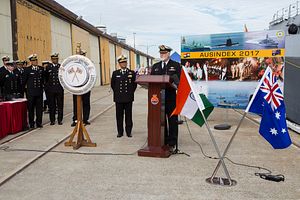After decades of being indifferent to each other, India and Australia have recently emerged as close strategic partners in the Indo-Pacific. This is evident in the number of high level visits and the number of joint military exercises between the two countries. Indian Navy Chief Admiral Karambir Singh was in Australia in early September, and the Indian Defense Minister, Rajnath Singh, is slated to visit Australia in November.
The shift in the relationship, both in terms of the tone and direction, is remarkable. This is primarily led by a common concern about a rising China and its strategic consequences on the Indo-Pacific strategic order. But there have been concerns about whether the two countries are on the same page: as Frederic Grare says in a 2014 paper, it is not clear if the common concerns have materialized into a shared approach in addressing the China factor.
Clearly, even as different countries have concerns about China, their concerns have been defined by local and often differing national interests and perspectives. Australia worries about China’s role and presence in the Pacific whereas India’s concerns are more to do with China’s increasing influence and activities in the Indian Ocean. And on the Indian Ocean, Australian analysts see little convergence and alignment of thinking with India. David Brewster for one, argues that “Australia is likely to be less willing to recognize any Indian claims of a ‘predominant’ maritime role in the Indian Ocean, much less any Indian sphere of influence in the north-east Indian Ocean.” But it is more important for India and Australia to come together in upholding rule of law, rules based order, respect human rights and establish norms of responsible behavior.
Despite this apparent mismatch in the thinking between the two capitals, maritime security concerns about the broad Indo-Pacific region has been gaining greater traction. The joint naval exercise, AUSINDEX, is a manifestation of this synergistic approach to maritime security. The third iteration held in April this year was the biggest so far between the two navies. Held off the coast of Visakhapatnam in southern India, it saw the participation of the highest number of units of the two countries so far including four frontline ships with integral helicopters, one submarine and a variety of aircraft including P8I and P8A long-range Maritime Reconnaissance Anti-Submarine Warfare aircraft. The exercise involved all three dimensions comprising anti-submarine warfare exercises, air defense exercises, and anti-surface warfare exercises. In a first, fifty-five American and twenty New Zealand military personnel were present to witness the exercise. According to an Indian government statement, “the increased scale of participation signifies the importance attached to the exercise by both countries while the enhanced complexity is indicative of the interoperability between the two navies.”
Therefore, it is clear that both New Delhi and Canberra have come a long way in their strategic engagements in a very short span of time, even if it has not advanced as fast as some observers would like to see. But this relationship will only further intensify in the coming years given that the common threat of a hegemonic China is unlikely to disappear anytime soon. It is quite likely that both countries will come to appreciate the increasing relevance of working together on a number of areas including maritime security, the establishment of a blue economy, infrastructure and connectivity initiatives, and strategic industry collaboration. The security dialogue, political consultations and bilateral and multinational military exercises can be expected to gain further depth and appreciation in both capitals. In addition, developing a common approach to certain ideas and principles like free, open and transparent Indo-Pacific is important.
Such strategic engagements will receive a major fillip with the visit of the Indian defense minister to Australia later this year. Reports suggest that India and Australia are likely to sign a number of important agreements including the mutual logistics support agreement, an information exchange agreement and a broader maritime agreement. A report citing diplomatic sources said that “These will lead to greater interoperability and help in elevating the strategic partnership.”
The logistics agreement has been in the discussion phase for a few years now and Australia is reported to have given India a draft text in 2016. It should be noted that India took more than a decade to finalize and conclude such an agreement with the United States. Ever since the LEMOA was concluded with the United States in 2016, it appears that India is getting a lot more comfortable with such agreements. Since 2016, India has signed two such agreements, one with France and a second one with South Korea, just a few weeks ago. These agreements go to enhance the interoperability between the militaries of the two countries, and simplify the process of using each other’s military facilities.
Maritime security cooperation, especially the information sharing arrangement, will help both sides to gain a better strategic awareness picture of the Indo-Pacific region. These have been on the bilateral agenda for some time – these were identified as elements in the India-Australia Joint Declaration on Security Cooperation signed during Prime Minister Kevin Rudd’s visit to India in 2009 as well as the Framework for Security Cooperation between India and Australia of 2014.
It is clear that the India-Australian strategic relationship has some way to go yet. But despite understandable disappointments about the slow pace, there are also advances being made.

































